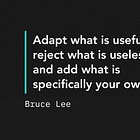
Welcome to Unknown Arts, where builders navigate AI's new possibilities. Ready to explore uncharted territory? Join the journey!
“Great things are not done by impulse, but by a series of small things brought together.”
Vincent Van Gogh
The tension of starting
I recently talked to fellow writer, technologist, and Better by Design community member
about our experiences starting entrepreneurial and artistic side-projects. As we spoke, I noticed that many of our shared struggles stemmed from tensions with our design backgrounds.Designers are trained to observe the world, talk to people, identify problems, and then start solving them. The problem is that starting from zero is notoriously ambiguous no matter how you slice it. You have no customers to talk to, only a general idea of the problem you’re solving, and limited resources to take action. It’s an environment where a designer’s tendency toward perfectionism can quickly become an insurmountable obstacle, blocking them from making a meaningful start.
That feeling isn’t unique to design. As an artist, it might manifest in some form of “writer’s block” and in business, it might surface as a variation of the Cold Start Problem.
The creative cold start problem
’s “Cold Start Problem” describes how companies build network effects that create momentum and eventually break through to popular success. When you're just starting out, you face the unique challenge of a negative network effect. In this scenario, people don’t get value from the network because there aren’t enough users yet. However, you can’t attract more users until you’ve built a substantial initial network. It’s a frustrating “chicken or the egg” dilemma that can leave companies stuck at square one, unable to gain traction.
I believe creative professionals experience their own cold-start problem. Before starting, the blank canvas looms large and can feel like a negative network effect, blocking you from taking a first step. After starting, building momentum is a challenge. But once you get some ideas flowing, more ideas tend to follow, behaving like a positive network effect that surfaces better work organically.
While Andrew outlines tactics to help unblock corporate cold starts, I want to explore a few ideas for unblocking creative cold starts. Let’s explore a handful of simple reframes for getting over that first hurdle and on your way to making something great.
Reframing problems of starting
“I don’t have a good enough idea yet”
I love Rich Roll’s mantra “mood follows action” for inspiring me to be more proactive about my mental health. It works just as well for creativity: “Creativity follows action”. If you find yourself waiting around for a good idea to surface on its own, you’re unlikely to discover anything.
Reframe:
Just make anything! Improvise! Any idea is acceptable to start.
The first thought may not amount to much, but the ideas that cascade from it might.
If you don’t have even one starter idea, take inspiration from something external. As I mentioned in my article on lessons from improv comedy, you can “mirror or do the opposite” with any creative input.
“I can’t live up to my grand idea”
I have unfortunate news: you won’t achieve your grand vision on the first attempt.
Just accept this reality and move on.
Ideal solutions are never feasible in the first build, but this shouldn’t stop you from making something. Since your first idea is rarely “the one” anyway, it’s a blessing to fly under the radar as you build toward the real deal.
Reframe:
Think of everything as an experiment and focus on prototyping. Build something lightweight just to try it out and see how it feels. If it’s good, great! But if not, no harm, no foul. You will have learned something and can redirect your energy in another direction that might be more fruitful.
“I’m not making something original”
Designers and engineers often fall into the trap of thinking they need to be 100% original. Seeking originality is catnip for our egos but more often than not, it’s an overreach that leads to getting stuck.
Achieving originality mostly comes from doing a lot of experiments to see what sticks while trying to be as authentic as possible in the process. Ultimately what’s original is you, your interpretation, and your execution, not an idea that’s probably been floating around for years.
Reframe:
Give yourself permission to use common patterns and remix. Collect building blocks and aim to never “start from scratch”. You’ll still make plenty of “original” choices while combining and reworking things you were inspired by.
“The early feedback is lacking… or too good”
Be very careful about your relationship to feedback early on.
On one hand, you might just be too early to share. The idea might be insufficiently developed for others to give you meaningful feedback. Just because they’re unable to clarify your hypothesis doesn’t necessarily mean you’re on the wrong path.
On the other hand, you need to be mindful of asking people with a vested interest in your success for their opinion. The classic example is asking your parents. Don’t ask them for feedback! They’re way too close to you to be able to give an impartial review so if you take their words at face value you’re going to end up somewhere you didn’t intend.
Reframe:
Look to two groups for the best early feedback:
An inner circle of people whose work you admire and whose opinions you trust. Like a writing circle for authors or songwriters or a “mastermind” group for business people.
Strangers. Since they have no stake in an ongoing relationship they can be truly, painfully real. Seeing their reactions is scary, but critical.
“I don’t want to make what the market is asking for”
Coming from a design background, it can feel almost sacrilegious to say that you don’t want to make what people are asking for. But if you’re feeling that way, the truth is that you’re just not the right person to solve that problem. That’s okay! It’s meant for someone else. There are other ideas out there waiting for you.
Reframe:
Seek to match your intrinsic and extrinsic motivations.
Look inward as much as you look outward and find the overlap between what lights you up and what resonates with people. If you discover something people want that you don’t want to make, don’t force it! Tell someone else who might be a better fit to solve that problem.
Then set your mind back to finding what you’re uniquely suited to provide.
Resources
If you got a little value from this post, consider subscribing or sharing. Follow me on X/Twitter and LinkedIn for more.






